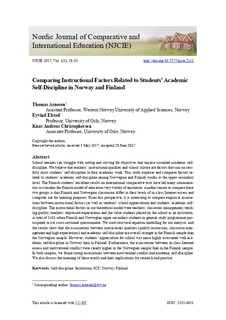| dc.contributor.author | Arnesen, Thomas | |
| dc.contributor.author | Elstad, Eyvind | |
| dc.contributor.author | Christophersen, Knut-Andreas | |
| dc.date.accessioned | 2019-10-14T12:22:21Z | |
| dc.date.available | 2019-10-14T12:22:21Z | |
| dc.date.created | 2017-12-19T11:22:02Z | |
| dc.date.issued | 2017 | |
| dc.identifier.citation | Arnesen, T., Elstad, E., & Christophersen, K. A. (2017). Comparing Instructional Factors Related to Students’ Academic Self-Discipline in Norway and Finland. Nordic Journal of Comparative and International Education (NJCIE), 1(1), 18-35. | nb_NO |
| dc.identifier.issn | 2535-4051 | |
| dc.identifier.uri | http://hdl.handle.net/11250/2621999 | |
| dc.description.abstract | School learners can struggle with setting and striving for objectives that require sustained academic self‐discipline. We believe that teachers’ instructional qualities and school culture are factors that can successfully elicit students’ self-discipline in their academic work. This study explores and compares factors related to students’ academic self-discipline among Norwegian and Finnish youths at the upper secondary level. The Finnish students’ excellent results on international comparative tests have led many commentators to consider the Finnish model of education very worthy of emulation. Another reason to com-pare these two groups is that Finnish and Norwegian classrooms differ in their levels of in-class Internet access and computer use for learning purposes. From this perspective, it is interesting to compare empirical associations between instructional factors (as well as students’ school appreciation) and students’ academic self-discipline. The instructional factors in our theoretical model were teachers’ classroom management, teaching quality, teachers’ expressed expectations and the value students placed on the school as an institution. A total of 1433 urban Finnish and Norwegian upper secondary students in general study programmes participated in our cross-sectional questionnaire. We used structural equation modelling for our analysis, and the results show that the associations between instructional qualities (quality instruction, classroom management and high expectations) and academic self-discipline are overall stronger in the Finnish sample than the Norwegian sample. However, students’ appreciation for school was more highly associated with academic self-discipline in Norway than in Finland. Furthermore, the associations between in-class Internet access and motivational conflict were clearly higher in the Norwegian sample than in the Finnish sample. In both samples, we found strong associations between motivational conflict and academic self-discipline. We also discuss the meaning of these results and their implications for research and practice. | nb_NO |
| dc.language.iso | eng | nb_NO |
| dc.publisher | OsloMet - Storbyuniversitetet | nb_NO |
| dc.relation.uri | https://journals.hioa.no/index.php/nordiccie/article/view/2111/2021 | |
| dc.rights | Navngivelse 4.0 Internasjonal | * |
| dc.rights.uri | http://creativecommons.org/licenses/by/4.0/deed.no | * |
| dc.subject | self-discipline | nb_NO |
| dc.subject | instruction | nb_NO |
| dc.subject | ICT | nb_NO |
| dc.subject | Norway | nb_NO |
| dc.subject | Finland | nb_NO |
| dc.title | Comparing Instructional Factors Related to Students’ Academic Self-Discipline in Norway and Finland | nb_NO |
| dc.type | Journal article | nb_NO |
| dc.type | Peer reviewed | nb_NO |
| dc.description.version | publishedVersion | nb_NO |
| dc.rights.holder | © The Authors. | nb_NO |
| dc.subject.nsi | VDP::Samfunnsvitenskap: 200::Pedagogiske fag: 280::Allmennpedagogikk: 281 | nb_NO |
| dc.source.pagenumber | 18-35 | nb_NO |
| dc.source.volume | 1 | nb_NO |
| dc.source.journal | Nordic Journal of Comparative and International Education (NJCIE) | nb_NO |
| dc.source.issue | 1 | nb_NO |
| dc.identifier.doi | 10.7577/njcie.2111 | |
| dc.identifier.cristin | 1529525 | |
| dc.relation.project | Norges forskningsråd: 218245 | nb_NO |
| cristin.unitcode | 203,6,1,0 | |
| cristin.unitname | Avdeling for lærarutdanning og kulturfag - Stord/Haugesund | |
| cristin.ispublished | true | |
| cristin.fulltext | original | |
| cristin.qualitycode | 1 | |

